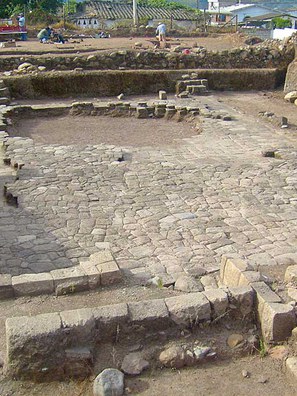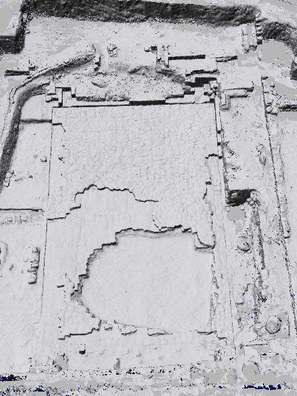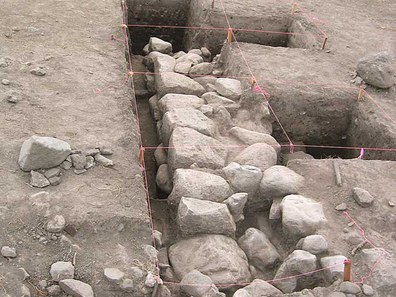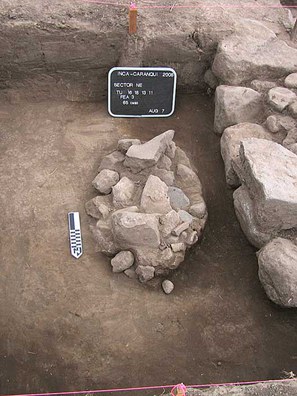Introduction
In late 2006, the local historic preservation organization known as FONSALCI (Fondo de Salvamento de Patrimonio Cultural, Cantón Ibarra) undertook exploratory excavations and cleaning operations on a recently acquired municipal lot in the parroquia of Caranqui. Situated on the lower northern slopes of Mt. Imbabura, Caranqui has long been recognized as the "centro antiguo" of the city of Ibarra by local residents. Numerous large earthen mounds or tolas dating to the late precolumbian period (AD 1200–1500), which once served as platforms for the construction of chiefly residences (Athens 1980; Oberem 1981), are known to have been clustered in this zone. Also preserved in Caranqui, directly across from the parish church, are two standing stone walls with multiple doors and niches that form part of a large rectangular Inca building (Bedoya 1990; Almeida 1995:44–46). The size of this building and its construction features suggest that it likely represents an Inca kallanka or great hall. The western edge of the lot acquired by FONSALCI in 2006 is situated approximately 50 meters to the northeast of this Inca building.

With the aid of a project grant from Dumbarton Oaks and a small award from the Office of International Programs at Wayne State University, we initiated the first phase of a long-term, collaborative program of research and conservation at the important site of Inca-Caranqui. During the 2008 field season, we focused on the precise documentation of the architectural features thus far exposed at the site; determining the probable limits of the religious precinct through the use of remote-sensing; assessing the immediate conservation needs of the site; and the limited testing of sub-surface anomalies detected on the north side of the semi-subterranean structure. These efforts yielded important preliminary results with respect to our understanding of site layout, late imperial architecture, the potential for additional subsurface elements, and conservation issues. To situate these results, we first provide a brief overview of the regional, cultural, and historical context of the site of Inca-Caranqui.
Cultural Historical Background
The site of Inca-Caranqui is located in the northern Ecuadorian highlands on the outskirts of modern Ibarra approximately 5 km south of Yaguarcocha, or Lake of Blood.
This lake takes its name from the legendary account of Inca vengeance wreaked upon the Caranqui, who-together with their neighbors, the Otavalos, Cayambes, and Cochasquis-are said to have successfully resisted Inca subjugation for 17 years (Cabello Valboa 1951 [1586]:361–386). When the Inca Huayna Capac finally prevailed, he reportedly exacted retribution in the form of a massacre of the entire male Caranqui population whose bodies were said to have been dumped in this lake. Cabello dates the end of the Caranqui wars to AD 1492, while Salomon (1986:146) suggests the final defeat may have been slightly later, circa AD 1500.
Prior to the crushing defeat eventually delivered by Inca forces, the site of Caranqui was likely the principal llacta of the eponymously named ethnic group (Athens 1980; Bray 2003; Caillavet 2000:155). Spanish chroniclers offer differing accounts of the Inca presence in Caranqui territory following these wars. Montesinos (1957 [1644]:111), for instance, states that Huayna Capac, within a year of his victory, ordered that a settlement based on the design of Cuzco be built [at Caranqui] for his court
and that a sumptuous palace to his father the sun be re-built
there. He also indicates that the ruler left his two-year old son, Atahualpa, in the care of authorities at Caranqui when he departed for Cuzco, reminding them that his son had been born in their land and would also be raised by there (ibid.). Betanzos (1987 [1551–57]:214–217), however, attributes imperial constructions at Caranqui to Atahualpa who is said to have ordered new edifices both to commemorate the death of his father and to serve as the focal point of his upcoming wedding and installation as successor. In either case, given the location of Inca-Caranqui at the far northern edge of Tawantinsuyu, we can confidently assign constructions here to the last stage of imperial expansion, with the strong possibility that the site may represent the last major building episode undertaken by the Inca state prior to the Spanish invasion.
Cieza de León, who passed through this region in 1546, provides the only eye-witness account of Inca-Caranqui prior to its final erasure from historical memory. In his diary, he makes special note of the fine "estanque" situated among the structures on a small central plaza. He describes this pool as hecho de piedra muy prima,
like the associated palaces and dwellings,
which were made of large, elegantly cut, and subtly fitted stones
(1986 [1550]: Ch.37). The fine pool he describes may well correspond to the semi-subterranean structure uncovered by Echeverría in late 2006, with its sophisticated system of associated hydraulic works that formed the focus of our investigations this past season. Cieza also reports that there had formerly been a Temple of the Sun at the site filled with large vessels of gold and silver and other riches
to which more than 200 acllakuna had been dedicated. He notes, in addition, that the Inca had had a permanent squadron of troops with their requisite captains stationed at Caranqui. In closing, Cieza (ibid.:123) states that even though [the site] is in total ruins today, one can see that it was a grand place in former times.
The ethnohistoric data suggest at least two possibilities regarding the origins and history of the site of Inca-Caranqui: e.g., that it was built by Huayna Capac to commemorate his hard-won victory and house his newborn son, or that it was built by Atahualpa to commemorate the death of his father and serve as the site of his royal investiture. Such reports highlight the important relations among imperial Inca architecture, succession, marriage, and filial duty, as originally suggested by Niles (1999). It is important to note that the two options indicated by the ethnohistoric sources are not necessarily mutually exclusive, as some of our preliminary findings seem to suggest. The projected long-term archaeological and architectural investigations at the site of Inca-Caranqui offer the possibility of verifying, augmenting, and enriching the ethnohistoric record as well as our understanding of late imperial practices and politics on the northern frontier. The preliminary results of the 2008 field season provide confirmation of the archaeological significance of this site.
Preliminary Results


Another priority this summer was to assess the potential for buried architectural features and remains at Inca-Caranqui. This was deemed essential for purposes of delimiting site boundaries and for conservation planning. To accomplish this objective, we employed ground-penetrating radar (GPR) with the technical assistance and expertise of Larry Conyers of the University of Denver. The site proved ideal for this type of remote-sensing procedure and yielded high resolution data on the presence, extent, and form of sub-surface features. Two of the anomalies indicated by the GPR data were tested during the second half of the field season. Through test excavations, we verified the presence of two fairly massive (1m thick), north-south trending Inca walls at the north end of the semi-subterranean "templo de agua."


We also uncovered a single undisturbed burial in association with the westernmost wall. These features were re-buried and will constitute an important focus of future investigations at the site.
Over the course of the summer, we also worked with an architectural conservator from Quito who is preparing a plan for the site; met with officials of the newly created Ministry of Culture, the Institute of Cultural Patrimony, and the new Fondo de Emergencia to try to secure funds for conservation and research at Inca-Caranqui; held on-site consultations with representatives of the Qhapaq Nan project; and worked closely with personnel in the FONSALCI office in Ibarra. Our efforts this summer at Inca-Caranqui produced high-quality, base-line documentation of the site as well as clear evidence of additional buried architectural features which help us to define the parameters of the ceremonial precinct of the site. The data generated will guide conservation planning efforts and provide a blueprint for future collaborative research at the site.
Acknowledgements
The following individuals contributed in various ways to the success of the 2008 field season at Inca-Caranqui and we are grateful for their support: Cesar Guerrero, Xavier Jaramillo, Víctor Palaguachi, and Miguel Chávez of FONSALCI; Mónica Bolaños, Oswaldo Tobar, and Cesar Toapanta of the INPC; Tim Wawryzniac and Boleslo Romero of the LiDAR Lab at the University of New Mexico; and Larry Conyers of the University of Denver. In addition, we wish to thank Robert Arrayunate, Daniela Balanzátegui, Karla Echeverría, Pedro Fiallos, Cristóbal Landázuri, Brian McCray, Cristina Muñoz, Maria Patricia Ordoñez, Josefina Vásquez, and MariAuxi Velasquez for their valuable assistance in the field; as well as Alfonso and Martina Pupiales of San Clemente for their warm hospitality.
References Cited
- Almeida, E., 1995. Monumentos Arqueológicos del Ecuador. Talleres del Instituto Geográfico Militar, Quito.
- Athens, J.S., 1980. El Proceso Evolutivo en las Sociedades Complejas y la Ocupación del Período Tardío-Cara en las Andes Septentrionales del Ecuador. Colección Pendoneros, Instituto Otavaleño de Antropología, Otavalo, Ecuador.
- Bedoya, A.,1979. Ruinas Arqueológicas en Caranqui. Boletín Histórico (9–10):152–157, (13–14):124–133.
- Bedoya, A., 1990. Recientes Investigaciones Arqueológicas en la Provincia de Imbabura. Talleres del Instituto Geográfico Militar, Quito.
- Betanzos, J., 1987. Suma y narración de los Incas (1551–1557). Translated and edited by María del Carmen Martín Rubio. Ediciones Atlas, Madrid.
- Bray, T.L., 2003. Los Efectos del Imperio Incaico el la Frontera Septentrional: Una Investigación Arqueológica. Abya-Yala Press, Quito.
- Bray, T.L., 2005. Archaeological Investigations in Northern Highland Ecuador: The Pimampiro District as a Multi-Ethnic Locale. Journal of Field Archaeology 30(2):119–141.
- Cabello Valboa, M., 1951 [1586]. Miscelánea Antarctica: Una Historia del Perú Antiguo.Universidad Nacional Mayor de San Marcos, Instituto de Etnologia y Arqueologia, Lima.
- Caillavet, C., 2000. Etnias del Norte: Etnohistória e História de Ecuador. Abya-Yala, Quito.
- Cieza de León, P., 1986. Crónica del Peru. Primera Parte [1550]. PUCP, Lima.
- Conyers, L., 2004. Ground-Penetrating Radar for Archaeology. AltaMira Press, Walnut Crk, CA.
- Montesinos, F., 1957 [1644]. Memorias antiguas historiales y politicas del Peru (17th century). Edited by L. Pardo. Revista del Museo e Instituto Arqueologico, Universidad Nacional del Cuzco 16–17:1–114.
- Niles, S., 1999. The Shape of Inca History. University of Iowa Press, Iowa City.
- Oberem, U., 1981. Cochasquí: Estudios Arqueológicos. (3 volumes). Colección Pendoneros, Nos. 3, 4, 5. IOA, Otavalo.
- Oberem, U., 1981. Los Caranquis de la sierra norte del Ecuador y su incorporación al Tahuantinsuyu. Contribución a la Ethnohistória Ecuatoriana, S. Moreno (ed.). Colección Pendoneros, No. 20. IOA, Otavalo.
- Salomon, F., 1986. Native Lords of Quito in the Age of the Incas. Cambridge University Press, Cambridge.